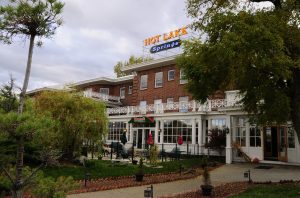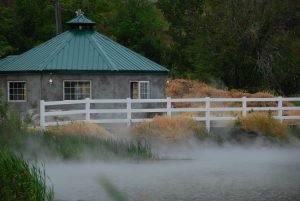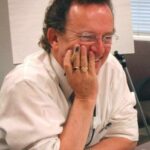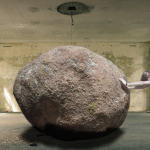22: The Veteran & the Naturopathic Doctor
 Education
Education
David J. Schleich, PhD
Every day of every year, year after year veterans take their own lives. Today 22 did. Yesterday 22 did. Tomorrow 22 will, unless we do something about it.
John Bickel, US Army Lt Col (Ret), Ranger (Airborne), West Point
There is a unique initiative taking shape in eastern Oregon. The partners include Oregon naturopathic physicians Dr John Winters, Dr Jim Massey, and Dr Sussanna Czeranko, as well as academic and administrative leaders at National University of Natural Medicine (NUNM); as well, there is a successful, entrepreneurial seafood protein producer from Texas called DyneAquaculture, pioneers in land-based, sustainable, recirculating aquaculture systems (RAS); and, there is the remarkably visionary husband and wife team, David and Lee Manuel. David Manuel is one of America’s most famous bronze sculptors. His masterpieces are in collections across America and beyond. Lee Manuel, his wife, is an indefatigable project manager, entrepreneur and community leader. In the past 13 years, they and their family and the La Grande community have resurrected the abandoned, derelict Hot Lake Sanatorium, long known as the “Mayo Clinic of the West” (Figure 1). Finally, and central to the dream, is a committed veterans support association called The Warrior Bonfire Program, serving disabled combat veterans through outdoor-oriented bonding events that enable the healing process.
These remarkable volunteers share Colonel Bickel’s call and vision that the time is now to take action to help wounded veterans. The project all these players are championing is called the Veterans Restorative Care Center (VRCC), and it is rising in the beautiful Blue Mountains surrounding Hot Lake Springs, just outside La Grande, Oregon, 170 miles from Boise and 260 miles from Portland (Figure 2). The VRCC will be a powerful and enduring enhancement in healthcare for our veterans and an enriching educational venue for naturopathic medical students.
Part of the gestalt of this unusual crucible of concerned people and entities is the Veterans Health Administration (VHA). A quick review of the VHA backstory – a federal agency hugely instrumental in the form, shape, pattern and configuration of services available to wounded veterans – will help make sense of why Hot Lake Springs is a very new presence in that landscape of veterans care. The VHA has been the driver of American healthcare for returning veterans ever since President Abraham Lincoln established the first federally funded soldiers’ and sailors’ hospital in Augusta, Maine, on November 1, 1866. Today, the VHA operates “one of the largest health care systems in the world” and “provides training for a majority of America’s medical, nursing and allied health professionals” (US Department of Veterans Affairs)
A Crisis in Care for Veterans
American veterans present with a large number of health issues. Physical injury, chronic disease and/or related chronic pain, diabetes, cardiovascular disease, anxiety, depression, traumatic brain injury, post-traumatic stress, suicide prevention, intimate partner violence, and more, are part of this equation of suffering. There are VA hospitals all over America, as well as telemedicine services, pharmaceutical services, OTC products, professional-grade herbals and supplements, substantial medical research, an online medical library, a database of information on health promotion, health conditions, treatments, and contacts. There is an array of other benefits that the VHA underwrites in its mandate to sustain healthcare for the men and women who have served in the American armed forces. At last count, the VA system operates 1221 outpatient sites, 300 veterans centers, 144 hospitals, 133 cemeteries, and 56 veterans’ benefits administration regional offices. (US Department of Veterans Affairs, Statistics) In that “infosurv” survey, almost two-thirds of respondents indicated that they would “prefer to see a doctor who prescribes natural therapies before considering drugs or surgery.” It gets better. An estimated 73% would “consider seeing a naturopathic physicians if that professional were on staff” at a VA facility. Important to note is that the VHA can actually assign naturopathic doctors to veteran care right now, since our profession has an employment code.
In the Northwest Network alone, where I live, there are over 80 VA health care systems, medical centers, outpatient clinics, integrated clinics, community-based outpatient clinics, and veterans centers. As of this past spring (March 2016), there are 8.97 million enrollees in the VA Health Care System. An estimated 4.26 million veterans receive VA disability compensation. Roughly 900 000 veterans receive vocational rehabilitation benefits. Around 7.1% of these veterans served in the Vietnam era, 7.3% in the Gulf War period, 1.7% in the Korean conflict, and 0.8% in World War II. At the moment, the United States has a Veteran population of 21 681 000.
Significant, too, in these data is that even as recently as 2012, 120 military facilities of the VA offered 275 CAM (complementary & alternative medicine) programs “producing 213,515 visits for active duty military members” (Integrative Medicine in the Military, 2014, p.231). Sadly, naturopathic professionals are not credentialed with the VA, and their overall participation in this astonishing network is minimal, even though the naturopathic repertoire is welcomed by veterans and is known to be so powerful in helping address the health needs of this massive population. Despite prescient comments such as those made by Tracy Gaudet, MD – director of the Veterans Health Administration’s Office of Patient Centered Care and Cultural Transformation – that naturopathic medicine is a “huge answer for the country, for practice, for patients” to the VHA’s own pledge to deliver “personalized, proactive, patient centered care,” naturopathic presence in the everyday challenges of helping veterans is marginalized. There are many historical, structural, and political reasons for these disconnects. The Hot Lake Springs project has the potential to move patiently through the rhetoric with results which will be demonstrable, sustainable, and accessible.
The New Veterans Restorative Care Center
The builders of the VRCC can well imagine that politicians such as Mark Pocan (D-WI), Julia Brownley (D-CA), Suzan DelBene (D-WA), Earl Blumenauer (D-OR), Raul Grijalva (D-AZ), and Walter Jones (R-NC) will be very interested to learn of the progress at Hot Lake, as will AMVET (American Veterans, an advocacy group for veterans, active and reserve) itself. Our American Association of Naturopathic Physicians, in fact, commissioned back in April 2015 a survey of vets, in which respondents were clear that they would prefer natural approaches to care, pointing out that they would access that care if it were available. (AANP, 2015) It can be available within the VA, since naturopathic physicians have an employment category in the professional definitions; however, the VA has chosen not to act.
Former Army Surgeon General, Eric Schoomaker, MD, PhD, spoke recently of the “imperative for integrative medicine in the military.” (Schoomaker, 2014) In that same year, the Pain Action Alliance to Implement a National Strategy (a network of over 40 pain-related organizations) reported,
When the military is building non-pharmacologic approaches and practitioners into multiple practices, few civilian settings have implemented practices that include significant opportunities to break the analgesic-pain cycle. Present evidence is more than sufficient to support early use of non-pharmacological strategies, including complementary and alternative care, in real world settings.
(Never Only Opioids, PAINS Policy Brief, 2014, p.4)
Detractors, though, are ever present. Dr Harriet Hall, Col, USAF (Ret) of the VA, for example, concluded that AMVET had been “hoodwinked” into supporting access by veterans to naturopathic care. The usual allegations about “unproven and pseudoscientific treatments” appear in her challenge. However, there is a number which another retired Colonel, with 3 tours of duty in Vietnam, would reflect back to his military colleague; that number is 22. (Hall, 2015)
Perhaps Dr Hall, whose concern for veterans is not unlike our own, will – once she takes notice of the VRCC project – take care to review the mounting evidence that holistic/naturopathic/alternative/complementary treatments [lots of terms to pick from in the invectives that zip back and forth] are definitively effective in treating chronic pain and definitely part of the healing equation for our veterans. What is likely is that the success of VRCC in Hot Lake Springs, once it is up and running, will make such anti-vitalistic, biomedicine proponents less reluctant to reach out inter-professionally to learn about therapies, approaches, and philosophies of healing for veterans that produce results different than the rates of chronicity and suicide indicate.
The avalanche of health concerns endured by returning veterans includes physical wounds, psychological issues, and psychosocial issues, according to retired Army Delta medic with 9 combat deployments, Sergeant Michael Chesney – one of the leaders of the VRCC founding partners, Warrior Bonfire Program. Chesney, a Delta Commando, has a quarter-century of active duty in his experience. He spoke eloquently at a recent 2-day planning event in La Grande about the need to blend the best approaches and treatments available to help him and his veteran brothers and sisters. Chesney himself escalated to 27 medications twice daily before shifting his life to a more balanced rhythm to restore his health. He further pointed out that the medical conditions faced by veterans are not 1 or 2 dozen, but hundreds. He believes strongly in naturopathic medicine.
There is an advocacy group for veterans called VFR. The Veterans of Foreign Wars of the United States has 1.7 million VFW and auxiliary members all over the world. This non-profit veterans’ service organization has been supporting returning soldiers since 1899. The VFR was instrumental in encouraging the VA to purchase care in the community, shifting the VA’s previous model of “only treating veterans for their service-connected disabilities and leaving them on their own for the rest of their health care.” (Veterans of Foreign Wars, 2016) In their report, the VFW lobbyists encourage the VA to “incorporate public/private partnerships and sharing agreements into the VA’s capital planning process” (p.4). VFW spokespersons also declared that “no one had cared to ask the veterans, whose needs the system was designed to serve, how they wanted to receive their health care” (p.2). The goal of their report earlier this year was to encourage the VA to integrate “local private and public health care capabilities into the veterans’ health care delivery model” so that veterans could “move seamlessly between VA and community care and expand access to more high-quality and timely health care options” (p.3).
In breakout groups at the gathering, vets spoke about not only stress ensuing from violent, horrific battlefield conditions, but also about neurotoxins they were exposed to. They referenced insomnia, irritability, chronic fatigue, skin disorders, memory loss, and more. Dr Jim Massey, ND, himself a veteran and retired captain, mentioned the importance of pondering, as inclusively as possible, the results of studies such as that done by the Research Advisory Committee on Gulf War Veterans illnesses. (Radford, 2008)
The VRCC Model is Wonderfully Sustainable
The beauty of the VRCC model is in its sustainability. The care facility will be owned by the Warrior Bonfire Program (WBP). All donations earmarked to support the VRCC will articulate through WBP, be tax-deductible, and totally transparent. WBP will fund the refurbishing of Hot Lake to support the mission and provide the construction capital to build the fish farm. DyneAquaculture will operate the farm at cost to ensure all profits go directly to the VRCC. Thus, the pressures which the VA faces in providing local, urgent, sustained, and appropriate care can be mitigated significantly in this project. In fact, the services provided for the veterans will not require VA financial support at all. DyneAquaculture’s CEO has committed to contributing all the profit directly to the Warrior Bonfire Group (WBG), a 501(c)(3) that will use that money for the purposes cited above. WBG is committed to repurposing the Hot Lake Springs facility to include residential facilities for inpatients and their families who avail themselves of the WBG program, which will include health care. They will build out a comprehensive naturopathic and classical Chinese medicine clinic. And, steady state, the WBG will use its DyneAquaculture revenue contribution to pay for the medical services the veterans need.
WBG’s and Dyne Aquaculture’s repurposing of the Hot Lake Springs building will benefit immensely from the Hot Lake spring water adjacent to the building. There will be a continuum of naturopathic care available, ranging from traditional naturopathic modalities such as hydrotherapy, balneotherapy, peloids, nutrition, botanical medicine, homeopathy, and more, to the entire spectrum of contemporary naturopathic care addressing the major presentations veterans will bring (Figure 3). Because naturopathic physicians in Oregon are primary care providers, a full spectrum of supportive holistic care, a full range of Classical Chinese Medicine therapies, and a comprehensive medicinary will be provided. Veterans will be supported for acute illnesses, anxiety, depression, sleep issues, digestive problems, wellness counseling, fatigue, headaches, back pain, and allergies. Services will include wellness exams, minor surgery, nutritional counseling, IV therapy, acupuncture, musculoskeletal assessment and treatment, and more.

Hydrotherapy Building; Hot Lake Springs
Naturopathic students from NUNM and other CNME-accredited programs will come to the Veterans Restorative Care Center at Hot Lake Springs as preceptors, as interns, and as residents. Care for veterans will be part of the repertoire of clinical experiences available to naturopathic students with such a focus. And, icing on the cake, research potential in terms of efficacy of treatment for veterans with various presenting conditions will not be far behind.
These partners have wounded veterans in mind. They also know that such a center of excellence will not go unnoticed.
References
- American Association of Naturopathic Physicians. Veterans Views on Naturopathic Physicians in the VA. April 2015. AANP Web site. http://www.naturopathic.org/files/About_Us/VA%20Survey%20Report%20-%20for%20posting.pdf. Accessed October 14, 2016.
- Hall, H. Keep Naturopathy Out of the VA! September 22, 2015. Science-Based Medicine Web site. https://www.sciencebasedmedicine.org/keep-naturopathy-out-of-the-va/. Accessed October 12, 2016.
- Integrative Medicine in the Military Health System Report to Congress. January 8, 2014. Submitted as Final Response to Senate Report 112-196, p. 231, accompanying HR 5856, Department of Defense Appropriate Bill; 2013. Available at: http://health.mil/Reference-Center/Reports/2014/01/08/Integrative-Medicine-in-the-Military-Health-System. Accessed October 12, 2016.
- Never Only Opioids. (2014). PAINS Project. Policy Brief. Fall, 2014 (5), 1-8. Available at: http://www.painsproject.org/wp/wp-content/uploads/2014/09/pain-policy-issue-5.pdf. Accessed October 12, 2016.
- Radford, B. (2008). The Realities of Mysterious Medical Maladies. November 20, 2008. Live Science Web site. http://www.livescience.com/7598-reality-mysterious-medical-maladies.html. Accessed October 12, 2016.
- Schoomaker, E. (2014). The Imperative for Integrative Medicine in the Military: A Personal and System Perspective. May 15, 2014. International Research Congress on Integrative Medicine and Health; Miami, FL. [Webcast] Available at: http://webcast.ircimh.org. Accessed October 12, 2016.
- U.S. Department of Veterans Affairs. About VA: History. Available at: http://www.va.gov/about_va/history.asp. Accessed October 14, 2016.
- US Department of Veterans Affairs. Department of Veterans Affairs Statistics at a Glance. May 2016. [Slide presentation] Prepared by the National Center for Veterans Analysis and Statistics. Available at: http://www.va.gov/vetdata/docs/QuickFacts/Homepage_slideshow_06_04_16.pdf. Accessed October 14, 2016.
- Veterans of Foreign Wars. (2016). A Framework for Veterans Health Care Reform. March 2016. VFW Web site. https://www.vfw.org/-/media/VFWSite/Files/Advocacy/NLS-Talking-Points-A-Framework-for-Veterans-Health-Care-Reform.pdf. Accessed October 12, 2016.
 David J. Schleich, PhD, is president and CEO of the National University of Natural Medicine (NUNM), former president of Truestar Health, and former CEO and president of CCNM, where he served from 1996 to 2003. Previous posts have included appointments as vice president academic of Niagara College, and administrative and teaching positions at St. Lawrence College, Swinburne University (Australia) and the University of Alberta. His academic credentials have been earned from the University of Western Ontario (BA), the University of Alberta (MA), Queen’s University (BEd), and the University of Toronto (PhD).
David J. Schleich, PhD, is president and CEO of the National University of Natural Medicine (NUNM), former president of Truestar Health, and former CEO and president of CCNM, where he served from 1996 to 2003. Previous posts have included appointments as vice president academic of Niagara College, and administrative and teaching positions at St. Lawrence College, Swinburne University (Australia) and the University of Alberta. His academic credentials have been earned from the University of Western Ontario (BA), the University of Alberta (MA), Queen’s University (BEd), and the University of Toronto (PhD).










